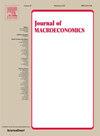A monetary policy accordion: Why do central banks from different countries expand and contract together?
IF 1.5
3区 经济学
Q3 ECONOMICS
引用次数: 0
Abstract
During recent decades, the monetary policies of central banks have shown significant co-movements mostly led by major economies such as the US. We find that this can be explained even when central banks adopt “inward looking” policy rules without aiming to stabilize exchange rates. We develop an open economy dynamic stochastic general equilibrium (DSGE) model with an agency problem in the banking sector. Our study suggests two channels through which the foreign and home policy rates co-move. Following the terms of trade channel, an exogenous rise in the foreign policy rate results in a capital outflow and a depreciation of the home currency. As import prices rise, home inflation increases and imports decrease. Then, via the Taylor rule, the home central bank raises its policy rate. The balance sheet channel coupled with a borrowing constraint amplifies the effects of the foreign policy rate shock. Due to the capital outflows that follow from the increase in the foreign rate, home banks experience a contraction of their balance sheets. The borrowing constraint then generates a feedback effect. This financial accelerator makes funding scarce, puts upward pressure on the user cost of capital, and feeds into even higher inflation. The policy co-movement becomes stronger when (a) global financial markets are more integrated, (b) the home country’s openness is higher, and (c) the home central bank is more aggressive in fighting inflation.
货币政策手风琴:为什么不同国家的央行会同时扩张和收缩?
近几十年来,各国央行的货币政策呈现出明显的协同运动,主要由美国等主要经济体主导。我们发现,即使央行在不以稳定汇率为目标的情况下采取“内向”的政策规则,这也可以得到解释。本文建立了一个考虑银行部门代理问题的开放经济动态随机一般均衡(DSGE)模型。我们的研究表明,国外政策利率和国内政策利率共同变动的两个渠道。在贸易条件通道之后,外生的外交政策利率上升导致资本外流和本国货币贬值。随着进口价格上涨,国内通货膨胀加剧,进口减少。然后,根据泰勒规则,本国央行提高政策利率。资产负债表渠道加上借贷约束,放大了外交政策利率冲击的影响。由于外币汇率上升导致资本外流,国内银行的资产负债表出现收缩。于是,借贷约束产生了一种反馈效应。这种金融加速器使资金稀缺,给用户资本成本带来上行压力,并导致更高的通胀。当(a)全球金融市场更加一体化,(b)母国的开放程度更高,(c)母国央行在抗击通胀方面更积极时,政策协同运动就会变得更强。
本文章由计算机程序翻译,如有差异,请以英文原文为准。
求助全文
约1分钟内获得全文
求助全文
来源期刊

Journal of Macroeconomics
ECONOMICS-
CiteScore
2.50
自引率
7.10%
发文量
53
审稿时长
76 days
期刊介绍:
Since its inception in 1979, the Journal of Macroeconomics has published theoretical and empirical articles that span the entire range of macroeconomics and monetary economics. More specifically, the editors encourage the submission of high quality papers that are concerned with the theoretical or empirical aspects of the following broadly defined topics: economic growth, economic fluctuations, the effects of monetary and fiscal policy, the political aspects of macroeconomics, exchange rate determination and other elements of open economy macroeconomics, the macroeconomics of income inequality, and macroeconomic forecasting.
 求助内容:
求助内容: 应助结果提醒方式:
应助结果提醒方式:


